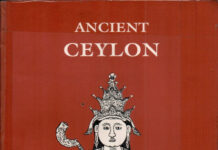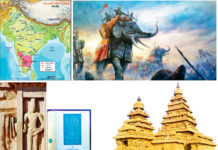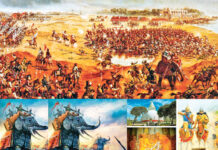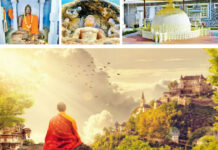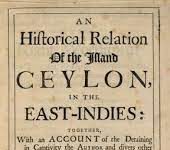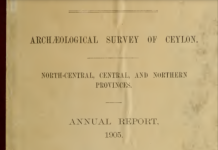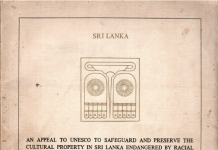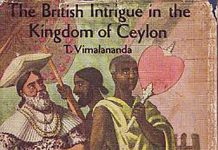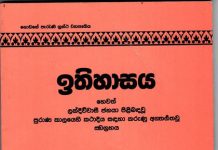By Vinod Moonesinghe
As Sri Lankan towns go, Colombo is relatively young—a mere five centuries from when the Portuguese established a fort and expelled the Muslim inhabitants. With the exception of Galle and Negombo, it is surely the city with the most colonial influence. The names of its streets and districts reflected its colonial heritage; at least until the authorities changed the names to more indigenous ones. Several of the surviving names have obscure origins. Here are some of them:
Maligakanda And Maligawatta
In May 1587, King Rajasinghe of Sitawaka, having conquered the Kandyan Kingdom, laid siege to the Portuguese fort of Colombo, with 60,000 men, 150 guns, 11,600 muskets and firelocks and 120 war elephants. The siege lasted nine months, but the 350 Portuguese soldiers in Colombo held out.
Under the Portuguese, the city walls encompassed the Pettah, and the Beira was much bigger than it is now. The fort could only be approached from the south and east, and a moat defended the eastern approaches. Rajasinghe ordered a deep ditch to be dug, thereby draining the eastern approaches. He located his headquarters on a hill further back, which came to be known as Maligakanda (palace hill), since he held court there. The fields adjacent became Maligawatte (palace gardens).
Hulftsdorp
In October 1655, a 10,000-strong army belonging to the Dutch East India Company (Verenigde Oost-indische Compagnie or V.O.C.), aided by 16,000 troops of King Rajasinghe II, laid siege to the Portuguese-held fort of Colombo.The Dutch commander, Gerard Pieterszoon Hulft, located his command post on a hill close to, and overlooking, the western rampart of the fort. During the course of the siege, Hulft went down to the front lines and received a bullet in his chest, expiring on the spot. A month later, in May 1656, the last 73 Portuguese troops, the only survivors of a bustling city of many thousands, surrendered. The Dutch hill on which Hulft had his headquarters became “Hulfts Dorp”, or “Hulft’s village”. Today, the name is often mis-spelt, as for example, Hultsdorf.

Wolvendaal
During the Dutch siege of Colombo, John van der Laan, Hulft’s second-in-command, quartered himself in a Portuguese church named for Our Lady of Guadalupe. The Dutch misconstrued (and mis-spelled) the name as “Agoa de Loepo” or “Quia de Lobo”, which they mistranslated as “Vale of Wolves”, Wolven Daal. It gained in importance after the Dutch built a church there, 375 years ago.
Our Lady of Guadelupe is a statue of the Virgin Mary, originally from Guadalupe in Spain, around which a cult formed. Interestingly, the place name actually derived from the Arabic “wadd al lubb”, meaning either “hidden river” or “river of wolves” (Arabic-speaking Muslims occupied much of Spain for seven centuries). “Guadalupe”, pronounced “waa da loope”, provided the Sinhala and Tamil term still used for the area, Aadilippu.
Jinthupitiya
The Anglican Church of St Thomas lies about 500 metres from Wolvendaal Church. The Portuguese reportedly found a Nestorian cross on the site(meaning that Persian Christians may have worshipped there) and therefore built a shrine there to St Thomas (São Tomé). During the siege of Colombo, the Dutch stationed several batteries here. After the Dutch took over, they demolished the shrine. In front of the shrine lay a large open space, which the Sinhalese called San Thome Pitiya, the field of St Thomas.The Dutch turned the field into a cemetery, part of which they turned over to graves of non-believers or “gentiles”, gentio in Portuguese (which was the lingua franca of Colombo until the mid-19th century). Hence, “the Field of St Thomas” became the “Field of Gentiles”, Gentio Pitiya, pronounced Jinthu Pitiya.
Aluthmawatha
Dutch Governor Petrus Vuyst, on landing in Colombo to take office in 1726, said he would rule “with the wisdom of Solomon and the boldness of Vuyst”. He suffered from a paranoid personality disorder, which manifested itself when he arrested several people on false charges, exiling some and executing 19 others by beheading, disemboweling and quartering them. After three years of his reign of terror, the V.O.C. recalled him to Batavia and had him beheaded whilst sitting in a chair (due to his status), disemboweled and quartered.
While still Governor, he fixated upon getting a good view of the Colombo harbour from a hill in Mutwal, called “Buona Vista” on account of the view. In order to get there faster and more comfortably, he had a new road built from the Pettah. Because carts could not get there, paving stones were passed from hand to hand. The new road came to be called Aluth Mawatha, “New Avenue”. Today it bears the repetitive moniker “Aluth Mawatha Road”.
Vystwyke Road
Vuyst’s residence at the Mutwal end of Aluth Mawatha came to be known as Vuyst Wyk (Vuyst’s village), commemorated today in Vystwyke Road. In this area, Vuyst’s bloodthirsty reputation received a further boost. A legend arose that Vuyst and his Malay cook developed a cannibal appetite, and that villagers travelling alone in the night near Vuyst Wyk would disappear. After Vuyst’s removal, a buried pile of bones came to light, or so rumour had it. A century later, residents claimed that Vuyst’s cries could be heard emanating from an abandoned well, as he did penance for his misdeeds in a burning iron chair.
Captain’s Garden
During the Dutch occupation, the Beira Lake extended as far as Hulftsdorp, much of what is now the railway yard between the Maradana and Fort stations being under water, with a peninsula sticking out into the eastern branch of the lake from Suduwella. Subsequent reclamation between this promontory and Lake House created D.R. Wijewardena Mawatha. In the 18th century, in order to regulate the activities of South Indian Chetties involved in the spice trade, the V.O.C. installed a Captain on this promontory. Accordingly, the peninsula came to be known as “Captain’s Garden”.
The Chetties worshipped a Shiva Lingam (sacred stone phallus) on the site, and the Captain, being a devout Christian, cast it into the Beira. The next day, it reappeared miraculously in the garden. Thereafter, the Captain allowed a Hindu temple, the modern Sri Kailasanatha Swami Devasthanam, to be built; the neighbourhood’s main claim to fame.
Bagatale And Alfred House
Charles Edward Layard, a member of the Ceylon Civil Service, purchased a bungalow in Kollupitiya,together with a large cinnamon plantation, stretching from the Galle Road to what is now Thurstan Road. He demolished the bungalow and built a mansion, and called the estate “Bagatelle”, most probably after the French game. The estate later passed into the hands of Arbuthnot and Co, agents for the Government of Ceylon in India. Jeronis de Soyza, a wealthy arrack rentier and planter, bought the house and estate. His son, Charles Henry de Soyza, an ardent monarchist, once entertained Queen Victoria’s son, Alfred Duke of Edinburgh (later Duke of Saxe-Coburg and Gotha) at the house, and thereafter renamed the mansion “Alfred House”. He also named after Alfred the model farm on the site of the present Royal Colombo Golf Club links. C. H. de Soyza’s heirs split up the estate, with the result that it sprouted a number of roads named after Alfred: Alfred House Gardens, Alfred House Road, Alfred House Avenue, and Alfred Place; also after the Queen: Queen’s Road and Queen’s Avenue; and after C. H. de Soyza himself: Charles Circus, Charles Avenue, Charles Way, Charles Place and Charles Drive. The original name of the estate remains in Bagatelle Road. Unfortunately, the Colombo Municipal Council in its wisdom decided that the correct spelling should be “Bagatale”, presumably meaning “plain of the gods”.

Layard’s Road/Broadway
Charles Edward Layard married Barbara Bridgetina Mooyaart, the daughter of Gualterus Mooyaart, an administrator in the V.O.C., and they had 20 children and over 200 grandchildren (I. G. P. Herbert Dowbiggin was a great-grandchild). One of their sons, Charles Peter Layard, joined the Ceylon Civil Service and went on to be acting Colonial Secretary and also the first Mayor of Colombo. He became a Knight Commander of the Order of St Michael and St George (K.C.M.G.) in 1876. In 1900, he represented the Governor at the inauguration of the Commonwealth of Australia.Layard’s Road in Bambalapitiya and Layard’s Broadway in Grandpass are named for him. Another, although unofficial, claim to fame is the Wellawatte Canal, built while Layard was Government Agent for the Western Province. Intended to drain flood waters, the level of the canal turned out to be too high, so the required flow did not take place. For this reason, it became known as “Layard’s Folly”.
Pennyquick Road
Pennyquick Road in Wellawatte is probably named for Charles Edward Ducat Pennycuick. Born in India in 1844, he lost his father Brigadier John Pennycuick at the Battle of Chillianwalla in the Punjab in 1849. He joined the Ceylon Civil Service and became Mayor of Colombo in 1893. Subsequently appointed Postmaster General, he finished his career as Treasurer of Ceylon, receiving a K.C.M.G. in retirement.
His elder brother, Colonel John Pennycuick, became quite famous in India. As an engineer in the Public Works Department, he built the Mullaiperiyar dam across the Periyar River in Kerala, and is worshipped as a god by farmers in the districts of the Madurai zone of Tamil Nadu, who irrigate their fields with waters from the reservoir. On the other hand, C. E. D. Pennecuick’s main claim to fame appears to be that, as Mayor, he considered objectionable the killing of stray dogs by drowning them in the Beira, so in 1894 he ordered the construction of a gas chamber for the purpose.) collided with a pony cart travelling from Regent Street to Jail Road (now E W Perera Mawatha, and Ananda Rajakaruna Mawatha) causing injury to the two cart riders and pony, and damage to the cart and harness. Credits to History of Ceylon Web Page and Wikipedia , photo credits to The Archives

